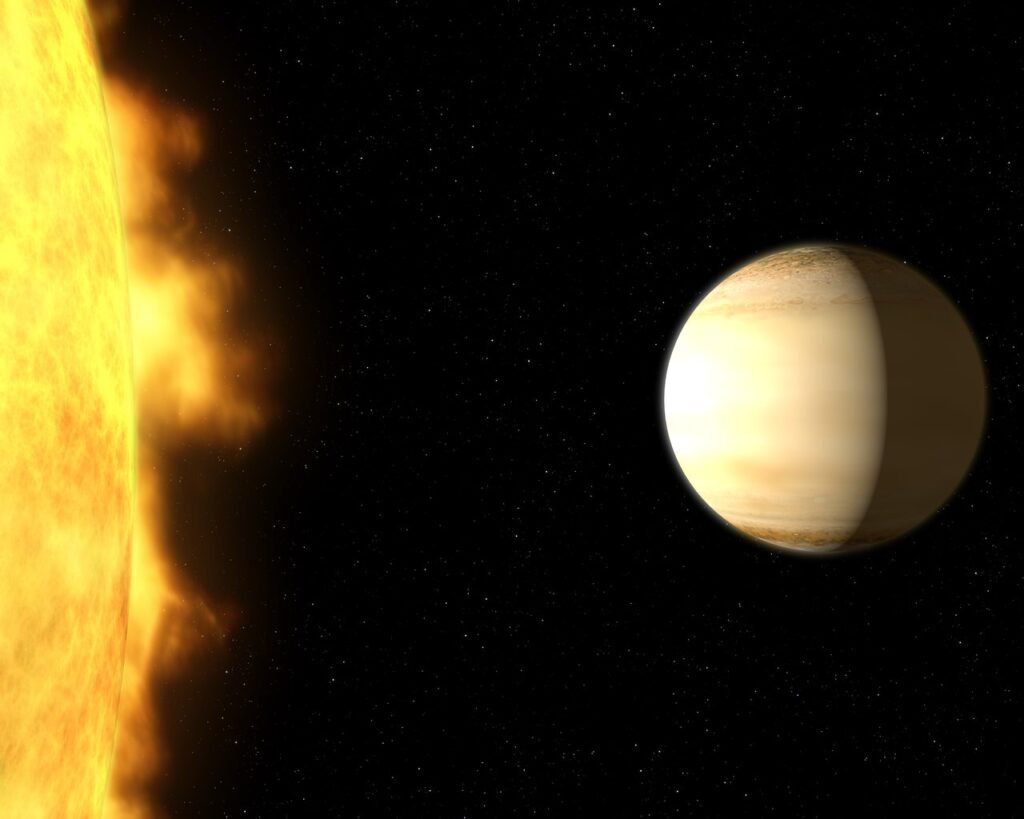
The James Webb Space Telescope uses infrared technology to look at distant stars, galaxies and exoplanets, as well as our Solar System. Image: Northrup Grumman.
“The James Webb Space Telescope (sometimes called JWST or Webb) is an orbiting infrared observatory that will complement and extend the discoveries of the Hubble Space Telescope, with longer wavelength coverage and greatly improved sensitivity. The longer wavelengths enable Webb to look much closer to the beginning of time and to hunt for the unobserved formation of the first galaxies, as well as to look inside dust clouds where stars and planetary systems are forming today” (NASA).
In a paper published on September 2022 in the journal Nature, the JWST Transiting Exoplanet Community Early Release Science Team announced the discovery of carbon dioxide (CO2) on the gas giant exoplanet WASP-39b.
Carbon dioxide is a key molecule that indicates “metallicity”, which is the presence of an environment rich in elements heavier than hydrogen and helium. Although this exoplanet, dubbed a “Hot-Jupiter” for its size and proximity to the star it orbits, is unlikely to host life, the ability of the JWST to detect complex molecules required by living organisms might bring us closer to finally finding lifeforms beyond our solar system.

Artist rendering of WASP-39b, which is eight times closer to its parent star, WASP-39, than Mercury is to the Sun. WASP-39b completes an orbit every four days. Source: NASA, ESA, and G. Bacon (STScI).
The exoplanet WASP-39b is a gas giant with a mass comparable to Saturn.
However, unlike Saturn, WASP-39b orbits its star at a close range, which makes the planet extremely hot. It’s 700 light-years away from Earth, and discoveries by astronomers using JWST’s predecessor, the Hubble Space Telescope, had already indicated the presence of a large amount of water in its atmosphere – about three times more than Saturn’s atmosphere contains.
The researchers are not sure of the source for carbon dioxide on WASP-39b. They expected the exoplanet to be composed of hydrogen and helium, the elements found in its hosting star. This surprising finding has raised several hypotheses, such as that the planet was bombarded by comets and asteroids in its early formation, or that the planet was formed outside the system and later entered the orbit of its star.
Data from NASA’s Spitzer Space Telescope had previously suggested that WASP-39b’s atmosphere might contain carbon dioxide, but the Webb confirmed expectations with the first clear evidence of such molecules in the atmosphere of an exoplanet – and with only a few hours of observation needed.
“We’ve had hints of it before, but this is the first time it’s really been a ‘punch in the face’ kind of detection”, said Dr. Jessie Christiansen, an astronomer at the NASA Exoplanet Science Institute at Caltech.
Despite the presence of carbon dioxide and water, the researchers believe there is little methane which would be required for what scientists refer to as biosignature, the indication of past or present lifeforms.
Because there is little methane, and the planet is so close to its star that its average temperature is 900°C, astronomers conclude that WASP-39b is a weak candidate for life. However, these observations may indirectly lead to future biosignature discoveries, by providing clues about how exoplanets are formed.
Dr. Natalie Batalha, an astronomer at the University of California at Santa Cruz, and her group at the Webb’s Transiting Exoplanet Early Release Science team are currently investigating WASP-39b in more detail and may soon publish new findings.
The JWST’s main goals are to locate and study the evolution of the first stars and galaxies formed after the Big Bang, and to investigate the potential for life in other parts of the universe. The telescope launched on December 25, 2021. On January 24 it arrived at its final orbit, and in July it became fully operational, releasing its first full-color images of our universe. Since then, there have been many important revelations.

This landscape of “mountains” and “valleys” speckled with glittering stars is actually the edge of a nearby, young, star-forming region called NGC 3324 in the Carina Nebula. Captured in infrared light by NASA’s new James Webb Space Telescope, this image reveals for the first time previously invisible areas of star birth. Image: NASA.
On November 2022, for instance, the JWST captured an incredible image of a previously-unseen region where new stars are born.
The telescope has also shed new light on the Stephan’s Quintet, a collection of galaxies in the Pegasus Constellation that was first discovered in the nineteenth century. The Quintet is located between 40 and 290 million light-years from Earth and is now teaching us more about the nature of supermassive black holes. In one of the Quintet’s galaxies is a black hole with a mass 24 million times that of our sun. These studies are helping scientists to unravel some of the mysteries that still surround black holes.

“The four galaxies within Stephan’s Quintet are undergoing an intricate dance choreographed by gravity. The Webb image (red, orange, yellow, green, blue) of this object features never-seen-before details of the results of these interactions, including sweeping tails of gas and bursts of star formation”. Image: NASA.
The telescope’s technology is helping scientists to unlock a whole new phase in exploring the universe.
The JWST weighs around six tons and cost $10 billion dollars to build over two decades. The Webb imaging system is so incredibly precise that it could see a coin at a distance of 40 km. In just one year since its launch, it has revealed endless possibilities of our universe and has surprised astronomers and the public. The telescope is allowing us to see further into the past of our universe than ever before, and scientists now have a new window to peer through dust clouds to the formation of stars.



